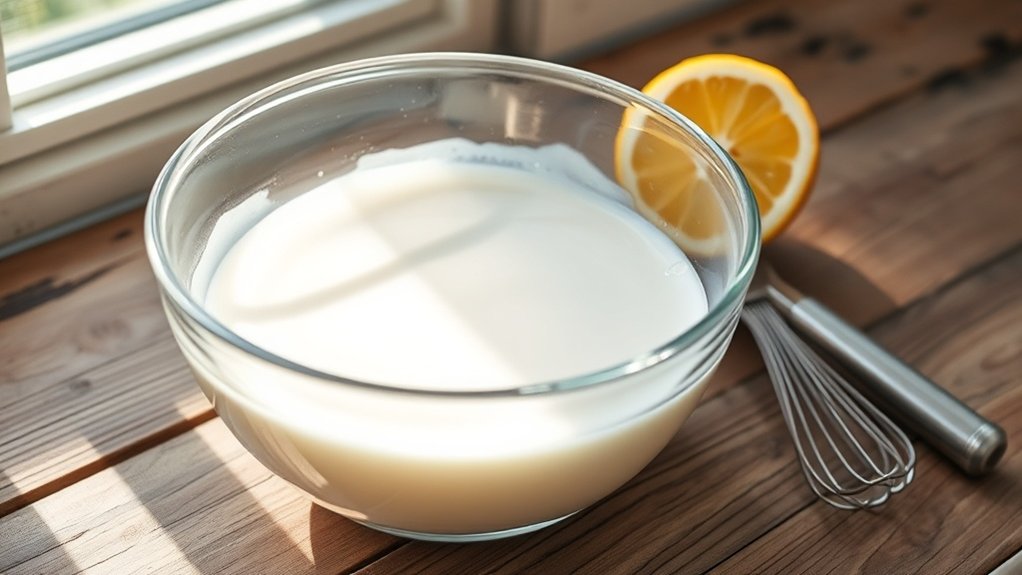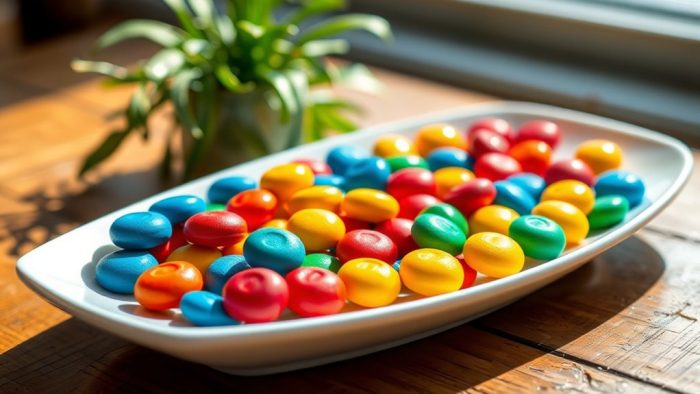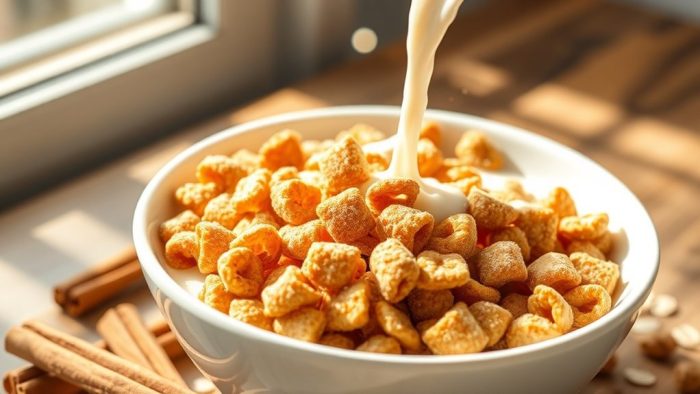How to Make Vegan Buttermilk

You’ll make vegan buttermilk by whisking together 1 cup of unsweetened plant milk with 1 tablespoon of acid—either fresh lemon juice or apple cider vinegar works perfectly. Let this mixture sit undisturbed for 5-10 minutes while it curdles and thickens, developing that signature tangy flavor. Soy milk delivers the best results thanks to its protein content, though oat milk works wonderfully too. This two-ingredient substitute reacts similarly to dairy buttermilk, creating those essential air bubbles that make your biscuits fluffy and your cakes tender. Below, you’ll find which plant milks yield ideal texture and how proper storage extends its three-day shelf life.
What Is Vegan Buttermilk?

Vegan buttermilk transforms plant-based milk into a tangy, acidic ingredient that mimics traditional buttermilk’s flavor and function.
You’ll create this dairy-free substitute by combining non-dairy milks with an acid like lemon juice or vinegar. The acid causes the milk to curdle slightly, developing that characteristic tangy flavor essential for baking.
This homemade alternative works equivalently to conventional buttermilk in recipes, helping your baked goods achieve a light and fluffy texture.
You can use soy, almond, or oat milk as your base, though soy milk’s higher protein content and creaminess make it particularly effective.
The simple substitution opens up countless vegan recipes that traditionally relied on dairy buttermilk, giving you the same rise and tender crumb without animal products.
Why Use Vegan Buttermilk in Baking?
You’ll find that vegan buttermilk works just like traditional buttermilk by reacting with baking soda to create those essential carbon dioxide bubbles that lift your cakes, muffins, and pancakes.
The acid in plant-based milk combined with vinegar or lemon juice doesn’t just activate leavening—it also tenderizes gluten strands for a softer crumb and adds that characteristic tangy brightness you expect in buttermilk baked goods.
Whether you’re making fluffy biscuits or tender coffee cake, this dairy-free alternative delivers the same chemical reactions and flavor depth as its conventional counterpart.
Activates Leavening Agents Effectively
When combined with baking soda, the acid in vegan buttermilk—whether from lemon juice, vinegar, or another acidic ingredient—triggers a chemical reaction that’s vital for proper leavening.
This acid-base interaction produces carbon dioxide bubbles that lift your batters and doughs, creating the rise you need in pancakes, cakes, and quick breads. Apple cider vinegar works particularly well for this purpose, neutralizing the baking soda while developing those significant air pockets.
The standard ratio of one tablespoon acid to one cup non-dairy milk creates the ideal environment for activating leavening agents.
Beyond just rise, vegan buttermilk’s creamy consistency helps improve texture throughout your baked goods, delivering a tender texture and moist crumb that rivals traditional recipes. This makes it indispensable for successful plant-based baking.
Creates Light, Fluffy Texture
The transformation from dense to delightfully airy happens the moment acid like vinegar meets plant-based milk in your mixing bowl. This vegan buttermilk creates the light and fluffy texture you’re craving in pancakes, biscuits, and cakes.
When combined with baking soda, the acidic non-dairy buttermilk produces carbon dioxide bubbles that lift your batter, resulting in a tender crumb throughout.
You’ll achieve prime results using unsweetened soy milk or other high-protein plant milks, as they provide the creaminess needed for superior structure.
The curdling action mimics traditional buttermilk’s properties while delivering that signature tangy flavor profile. This simple substitution guarantees your vegan baked goods rise beautifully and maintain their soft, pillowy consistency—proving that plant-based ingredients perform just as effectively as their dairy counterparts.
Adds Tangy Flavor Profile
Beyond texture improvement, vegan buttermilk delivers that distinctive sharp, tangy punch that transforms ordinary baked goods into flavor-forward creations.
The acidity from combining plant-based milk with lemon juice or vinegar creates this signature tang that’ll increase everything you bake.
This tangy flavor profile mimics traditional buttermilk remarkably well, making it an ideal dairy-free substitute when you’re avoiding animal products. You’ll notice how the tartness balances sweetness in cakes and pastries, preventing desserts from tasting one-dimensional or cloying.
The beauty of vegan buttermilk extends to savory applications too. When you incorporate it into cornbread or biscuits, that acidic bite adds complexity and depth while keeping everything moist.
Your plant-based creations will taste authentically tangy without compromising your dietary choices.
Best Plant Milks for Vegan Buttermilk
Not all plant milks curdle comparably when you’re making vegan buttermilk, so choosing the right base matters for achieving that thick, tangy consistency.
Soy milk and oat milk lead the pack due to their protein content and reliable curdling properties, while thicker almond and cashew milks offer workable alternatives with varying results.
You’ll want to skip watery options like flax milk and consider whether hemp milk’s distinctive flavor fits your recipe before committing.
Top Recommended Milk Options
Among plant milks, avoid flax milk—it’s too thin to curdle properly.
When selecting your base, prioritize unsweetened varieties with higher protein content for best results in any application requiring vegan buttermilk.
Milks to Avoid
Flax milk proves too thin to curdle effectively, producing watery vegan buttermilk that lacks body.
Cashew milk presents a different challenge—while usable, it doesn’t curdle at all, limiting its effectiveness in recipes requiring that characteristic texture.
Even almond milk requires careful selection; thinner varieties fail to curdle properly. Stick with thicker brands like Califia Farms if you’re choosing almond milk for better results.
Choosing the Right Acid: Lemon Juice, Vinegar, or Cream of Tartar

When crafting vegan buttermilk, your choice of acid determines both the texture and flavor profile of your final dish. Freshly squeezed lemon juice stands as the preferred option, delivering a bright, tangy flavor while effectively curdles non-dairy milk.
Vinegar—whether apple cider vinegar or white vinegar—serves as an excellent alternative, producing comparable results with a subtler tang. If you’re seeking something different, cream of tartar works too; simply combine a teaspoon with your plant-based milk for curdling action.
Consider how your acid selection influences your baked goods‘ taste. Lemon juice imparts freshness, while vinegar offers understated complexity.
Both options activate baking soda reliably, making certain proper rise through chemical reaction with alkaline components. Your acid choice shapes everything from pancakes to cakes.
The Science Behind Vegan Buttermilk
Understanding the chemistry of vegan buttermilk transforms you from recipe-follower to confident baker. When you combine non-dairy milk with acid, you’re triggering a deliberate curdling process that mimics traditional buttermilk’s texture and function.
Here’s what happens at the molecular level:
- Acid meets milk: Lemon juice or vinegar lowers the pH, causing proteins to coagulate and curdle.
- Thickness develops: The curdled proteins create the signature thick consistency needed for baking.
- Leavening activation: When mixed with baking soda, the acid produces CO2 gas bubbles.
- Rise occurs: These gas bubbles expand during baking, creating fluffy, well-risen results.
Soy milk excels as your base because its higher protein content guarantees better curdling and superior texture.
This leavening agent interaction mirrors dairy buttermilk’s performance, proving plant-based substitutions work through science, not magic.
Step-By-Step Recipe With Ratios

Making vegan buttermilk requires just two ingredients in a precise ratio: combine 1 tablespoon of acid (apple cider vinegar or lemon juice) with 1 cup of unsweetened plant milk.
You’ll want to choose soy milk for its superior protein content, which creates a thicker, more authentic texture than lighter options like almond or flax.
Stir the mixture together and let it rest for 5-10 minutes until you see visible curdling—that’s when you know it’s ready to use in your recipes.
Basic Ingredient Ratios
The golden ratio for vegan buttermilk couldn’t be simpler: 1 tablespoon of acid whisked into 1 cup of unsweetened plant milk. This straightforward recipe works with lemon juice or apple cider vinegar to make your homemade mixture curdle properly.
Soy milk delivers superior results thanks to its protein content and creamy texture.
Essential ratio guidelines:
- Single batch: 1 tablespoon acid + 1 cup plant milk
- Double batch: 2 tablespoons acid + 2 cups plant milk
- Triple batch: 3 tablespoons acid + 3 cups plant milk
- Custom amounts: Maintain 1:1 tablespoon-to-cup proportion
Always choose thicker plant milks for ideal curdling. While soy remains perfect, oat and dense almond varieties work well too.
Avoid thin milks like flax or coconut—they won’t achieve the necessary consistency for baking success.
Preparation Instructions Explained
Once you’ve gathered your plant milk and acid, start by measuring 1 cup of cold, unsweetened plant-based milk into a clean glass or bowl.
Add 1 tablespoon of apple cider vinegar or lemon juice directly to the milk. Gently stir the mixture to combine, then let it sit undisturbed for 5-10 minutes.
During this time, you’ll notice the acid causes the milk to curdle and thicken, transforming into vegan buttermilk with that characteristic tangy flavor and slightly thicker texture.
For larger quantities, simply maintain the 1:1 ratio—one tablespoon of acid per cup of milk.
Once ready, you can use it immediately in your recipes or transfer it to an airtight container and store in the fridge for up to three days.
Shake well before using if separation occurs.
How Long to Let Vegan Buttermilk Sit
After mixing your acid and plant milk together, patience becomes your secret ingredient.
You’ll need to let the mixture sit for 5-10 minutes to properly curdle and thicken. During this time, the acidity transforms your non-dairy milk into vegan buttermilk with authentic tang and texture.
Here’s your timeline for success:
- Mix your acid with plant milk
- Wait 5-10 minutes at room temperature for curdling
- Stir gently to achieve even consistency
- Use immediately or store in the refrigerator
Your choice of non-dairy milk matters—soy milk delivers superior thickness and creaminess.
Once prepared, vegan buttermilk should be used within 2-3 days when refrigerated. If separation occurs during storage, simply shake to recombine before incorporating into your recipes.
Storage and Shelf Life

Making vegan buttermilk fresh offers immediate satisfaction, but proper storage extends its usefulness throughout your week.
Store your prepared vegan buttermilk in an airtight container in the refrigerator for up to 3 days without quality loss. You’ll notice separation during storage, so shake or stir thoroughly before each use to redistribute the curdles and acidity.
For extended storage, freeze portions in ice cube trays for up to 3 months. This method provides convenient single-serving portions whenever you’re baking.
When needed, thaw frozen cubes in the refrigerator to preserve the cultured texture and tangy flavor. Making vegan buttermilk up to 3 days ahead simplifys your cooking process, making certain you’ve got this essential plant-based ingredient ready for pancakes, biscuits, or dressings.
Recipes That Use Vegan Buttermilk
Your homemade vegan buttermilk transforms ordinary recipes into extraordinary plant-based creations across breakfast, dinner, and dessert categories.
This versatile homemade vegan buttermilk substitute activates baking soda through its acidity, creating remarkable results in vegan baking.
Essential Vegan Buttermilk Recipe Applications:
- Breakfast Favorites – Whip up vegan buttermilk pancakes for fluffy morning stacks, or prepare vegan buttermilk biscuits with tender crumbs and classic flavor.
- Decadent Desserts – Your vegan buttermilk recipe improves moisture and tang in vegan vanilla cake, raises red velvet variations, and enriches vegan blueberry cobbler with deeper flavor notes.
- Savory Creations – Add depth to Vegan Southwest Skillet Cornbread, achieving balanced taste and delightful texture.
- Textural Benefits – The acidity tenderizes batters while adding subtle tang, making it indispensable for achieving professional-quality results.
Troubleshooting Common Issues

Why does vegan buttermilk sometimes fail to curdle or perform as expected?
Temperature matters—use cold milk, as warmth prevents proper curdling. Always choose unsweetened, plain varieties; flavored options compromise tanginess and texture.
If you’re making buttermilk with thin results, switch to soy milk or premium almond milk for better consistency.
Timing is essential for best results. Let your mixture sit for 5-10 minutes minimum after adding vinegar or acid. Insufficient resting prevents adequate curdling needed for baking success.
When separation occurs during storage, don’t worry—simply shake the container vigorously to re-emulsify. The acid naturally causes the milk proteins to curdle and separate, but this doesn’t indicate spoilage.
Understanding these plant-based reactions helps you troubleshoot confidently and achieve consistent, reliable vegan buttermilk every time.





